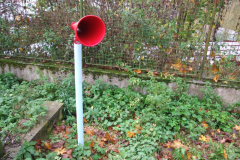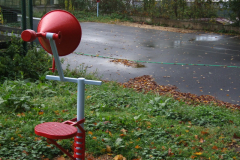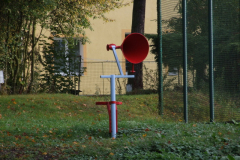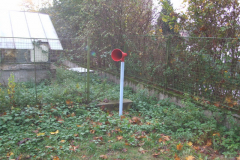A directional hearing aid allows you to capture and amplify less distinct sounds. With hearing aids you can try to record for instance sound symptoms of birds, their communication, different vocalisations of birds nesting or just loosely sitting on trees, etc.
The device is placed on the stand and of adjustable height and direction.

Source: http://translate.google.cz/translate?hl=cs&langpair=en|cs&u=http://www.hearingaidmuseum.com/
A hearing trumpet made of nickel-plated brass ranks among the typical products from the years 1880 to 1920 and was first made by an unknown producer in the United States sometime around 1910. Once captured, the sound is drafted into the ear through a metal attachment.

Source:
http://upload.wikimedia.org/wikipedia/commons/b/b8/Ear.jpg
The ear lobe is used to capture sound waves.
Any acoustic wave captured by the ear is directed into an approximately 3, 00 cm-long ear canal. At the very end of the canal the focused wave runs into an approximately 0.1 mm-thick elastic fibrous membrane (drum) to vibrate it. After amplification the gained sound signal travels farther into the inner ear.
Human-audible frequencies are those with waves ranging from approximately 20 Hz to about 20 kHz.

Source: http://cs.wikipedia.org/wiki/Soubor:Anatomy_of_the_Human_Ear-CZ.svg
Examples of historic hearing aids:

Source: http://en.valka.cz/files/naslouchadlo_131.jpg

Source: http://forum.valka.cz/files/121_big_302.jpg
Anti-aircraft gunners are guarding the skies in one of the districts of the German army-besieged Leningrad using directional hearing aids (1942). Two men sit facing each other and tubes go into their ears. Each of the tubes is attached to a hearing aid. One man receives sounds from the pair of hearing aids on the horizontal axis and the other those from that on the vertical axis. Each soldier is controlling their sighting wheel in order to get the strongest signal (ie one takes the elevation and the other takes the direction). Two other members of the patrol report the data found somewhere away to a place from where the firing is controlled. At that time, the Soviet Army suffered from a deficiency of modern radars.
Edison phonograph

Source: http://upload.wikimedia.org/wikipedia/commons/a/a0/EdisonPhonograph.jpg
The first device able to record and reproduce sound, constructed in August 1877 by Thomas Alva Edison, was patented a year later under the name phonograph.
Recording (and also reproduction) of sound was conducted through a large mouthpiece (metal funnel), which amplified the sound. The bottom of the funnel was sealed with parchment membrane (originally from the gas bladder of fish). At the end of the diaphragm a needle was stuck to the membrane. The needle transferred oscillations and recorded them to a helix-style rotating cylinder. Phonograph cylinders were first covered with tinfoil, which was later replaced with a mass similar to wax.
Phonographs with rollers were later replaced by turntables, which played back much more space-saving flat plates.

Source: http://mila.izkustvo.net/wp-content/uploads/2008/06/hmveg_record.jpg

His Master’s Voice
Source: http://www.oldtimegifts.co.uk/images/detailed/0/19STEEL27.jpg

Megaphone
The Effort to extend the range of human voice is age-old. But until the 17th century, human hands attached to the mouth served as the only „amplifier“ of human voice. From 1670 onwards it was possible to amplify the voice with the megaphone.
With the help of a megaphone we can inflate sound waves, send sound in one direction and thus suppress its rapid dissipation into space. The walls of the tubes do not allow the sound waves to run sideways.

Source: http://www.imramovsky-marine.cz/jpg/jpg106/10618/n2141_520x418.jpg
Using the megaphone you will produce a stronger voice indeed. This will become evident soon, as talking via megaphone is more strenuous. The walls of the funnel push the sound waves a bit back as well and you have to employ the vocal chords in order to chase them out.






